Strategic Marketing: STP Analysis, Application, and Recommendations
VerifiedAdded on 2021/12/15
|18
|4272
|83
Report
AI Summary
This report delves into the core principles of strategic marketing, focusing on the Segmentation, Targeting, and Positioning (STP) framework. It begins with a critical analysis of STP's functions and importance, emphasizing its role in identifying and selecting potential customers. The report then explores the application of STP concepts to various organizations, providing insights into real-world marketing strategies. It examines the segmentation process, considering factors like demographics and customer preferences, and discusses the selection of target markets and the development of positioning strategies to create a unique brand image. The report includes case studies of American Express, Emirates, and Fly Dubai, illustrating how these companies utilize STP. Finally, it offers recommendations for organizations to leverage the STP model effectively, considering current market trends and challenges like globalization and e-commerce. This report is a valuable resource for understanding and applying STP in marketing.

Running Head: STP 0
STRATEGIC MARKETING
STRATEGIC MARKETING
Paraphrase This Document
Need a fresh take? Get an instant paraphrase of this document with our AI Paraphraser
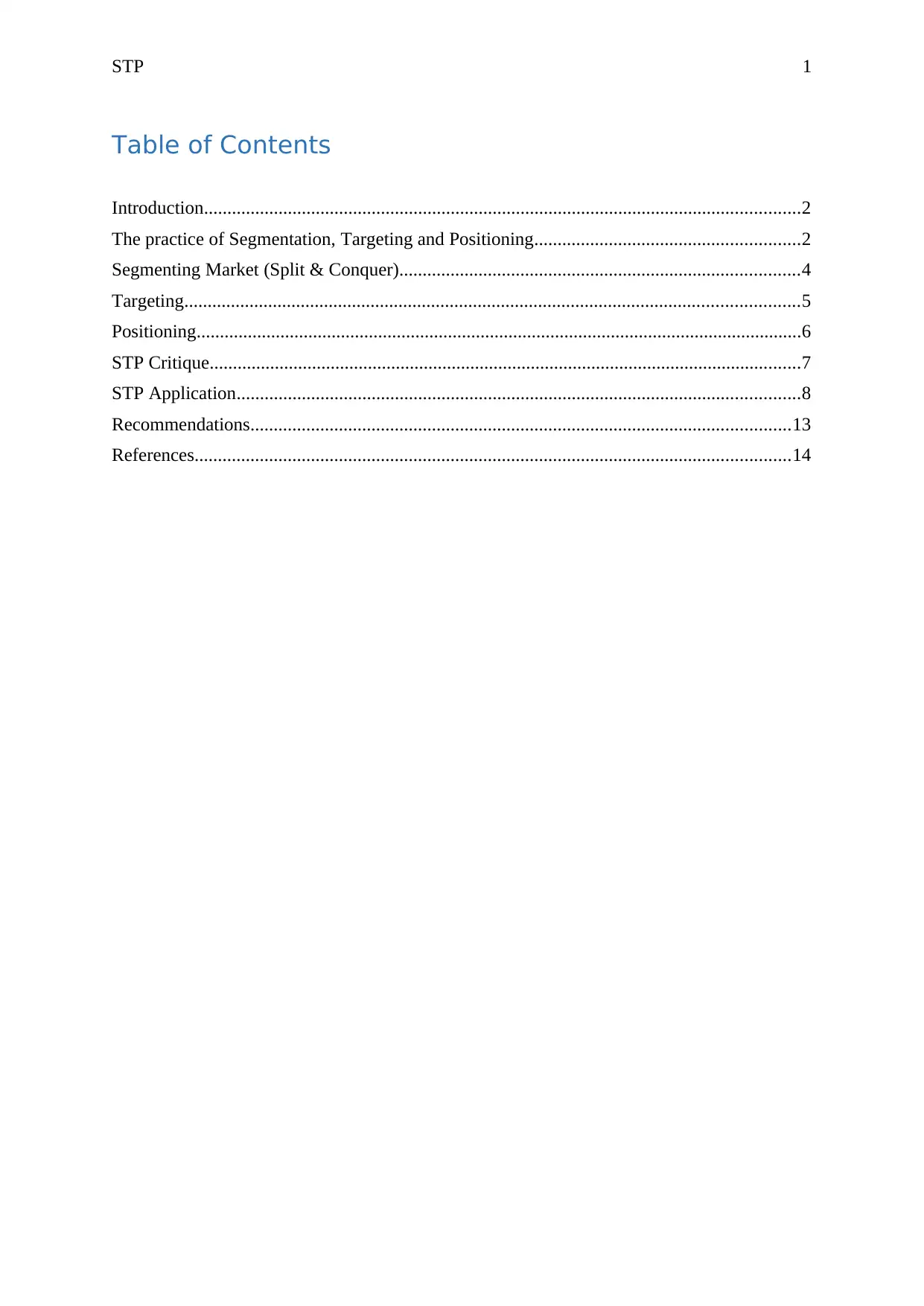
STP 1
Table of Contents
Introduction................................................................................................................................2
The practice of Segmentation, Targeting and Positioning.........................................................2
Segmenting Market (Split & Conquer)......................................................................................4
Targeting....................................................................................................................................5
Positioning..................................................................................................................................6
STP Critique...............................................................................................................................7
STP Application.........................................................................................................................8
Recommendations....................................................................................................................13
References................................................................................................................................14
Table of Contents
Introduction................................................................................................................................2
The practice of Segmentation, Targeting and Positioning.........................................................2
Segmenting Market (Split & Conquer)......................................................................................4
Targeting....................................................................................................................................5
Positioning..................................................................................................................................6
STP Critique...............................................................................................................................7
STP Application.........................................................................................................................8
Recommendations....................................................................................................................13
References................................................................................................................................14
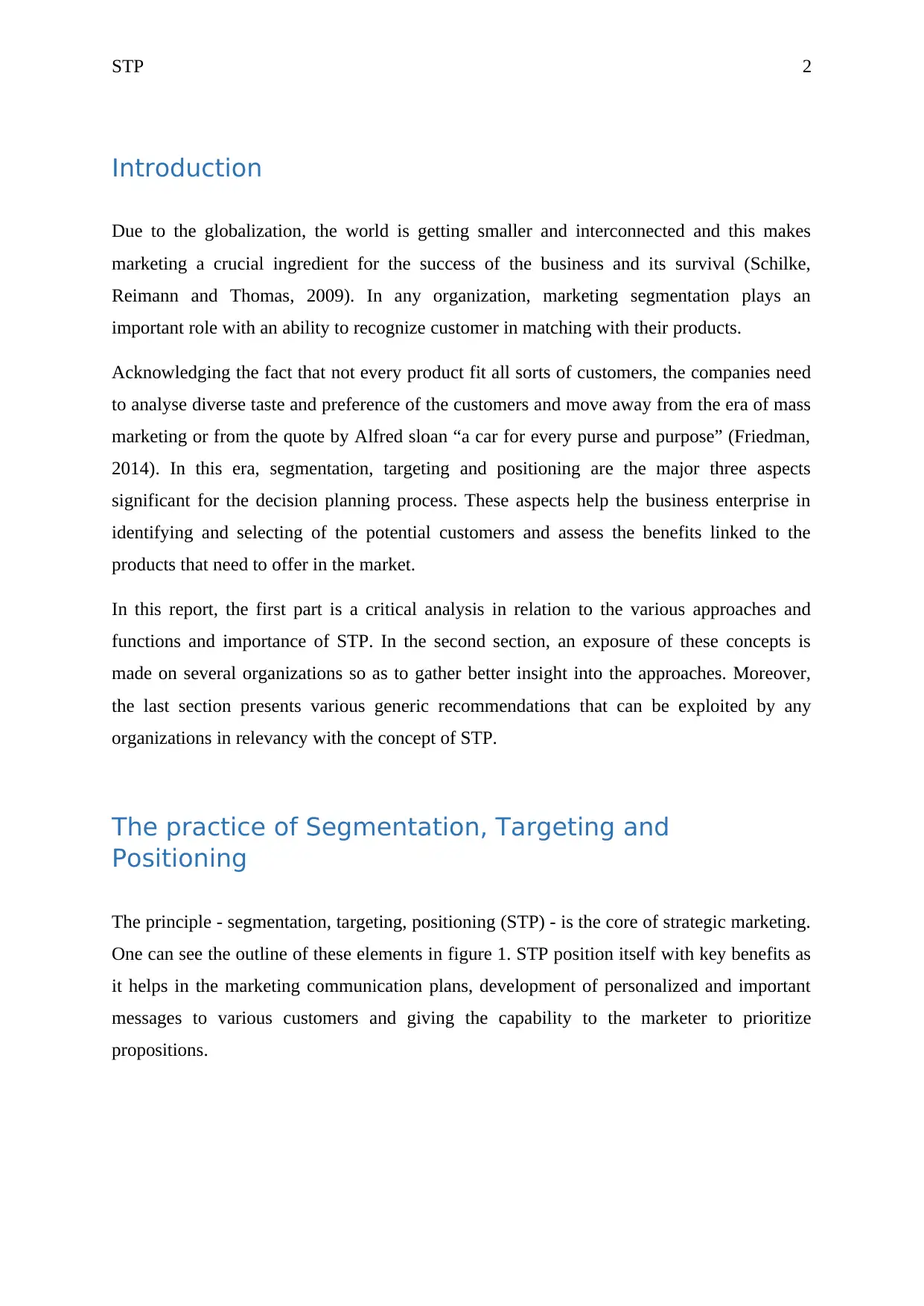
STP 2
Introduction
Due to the globalization, the world is getting smaller and interconnected and this makes
marketing a crucial ingredient for the success of the business and its survival (Schilke,
Reimann and Thomas, 2009). In any organization, marketing segmentation plays an
important role with an ability to recognize customer in matching with their products.
Acknowledging the fact that not every product fit all sorts of customers, the companies need
to analyse diverse taste and preference of the customers and move away from the era of mass
marketing or from the quote by Alfred sloan “a car for every purse and purpose” (Friedman,
2014). In this era, segmentation, targeting and positioning are the major three aspects
significant for the decision planning process. These aspects help the business enterprise in
identifying and selecting of the potential customers and assess the benefits linked to the
products that need to offer in the market.
In this report, the first part is a critical analysis in relation to the various approaches and
functions and importance of STP. In the second section, an exposure of these concepts is
made on several organizations so as to gather better insight into the approaches. Moreover,
the last section presents various generic recommendations that can be exploited by any
organizations in relevancy with the concept of STP.
The practice of Segmentation, Targeting and
Positioning
The principle - segmentation, targeting, positioning (STP) - is the core of strategic marketing.
One can see the outline of these elements in figure 1. STP position itself with key benefits as
it helps in the marketing communication plans, development of personalized and important
messages to various customers and giving the capability to the marketer to prioritize
propositions.
Introduction
Due to the globalization, the world is getting smaller and interconnected and this makes
marketing a crucial ingredient for the success of the business and its survival (Schilke,
Reimann and Thomas, 2009). In any organization, marketing segmentation plays an
important role with an ability to recognize customer in matching with their products.
Acknowledging the fact that not every product fit all sorts of customers, the companies need
to analyse diverse taste and preference of the customers and move away from the era of mass
marketing or from the quote by Alfred sloan “a car for every purse and purpose” (Friedman,
2014). In this era, segmentation, targeting and positioning are the major three aspects
significant for the decision planning process. These aspects help the business enterprise in
identifying and selecting of the potential customers and assess the benefits linked to the
products that need to offer in the market.
In this report, the first part is a critical analysis in relation to the various approaches and
functions and importance of STP. In the second section, an exposure of these concepts is
made on several organizations so as to gather better insight into the approaches. Moreover,
the last section presents various generic recommendations that can be exploited by any
organizations in relevancy with the concept of STP.
The practice of Segmentation, Targeting and
Positioning
The principle - segmentation, targeting, positioning (STP) - is the core of strategic marketing.
One can see the outline of these elements in figure 1. STP position itself with key benefits as
it helps in the marketing communication plans, development of personalized and important
messages to various customers and giving the capability to the marketer to prioritize
propositions.
⊘ This is a preview!⊘
Do you want full access?
Subscribe today to unlock all pages.

Trusted by 1+ million students worldwide
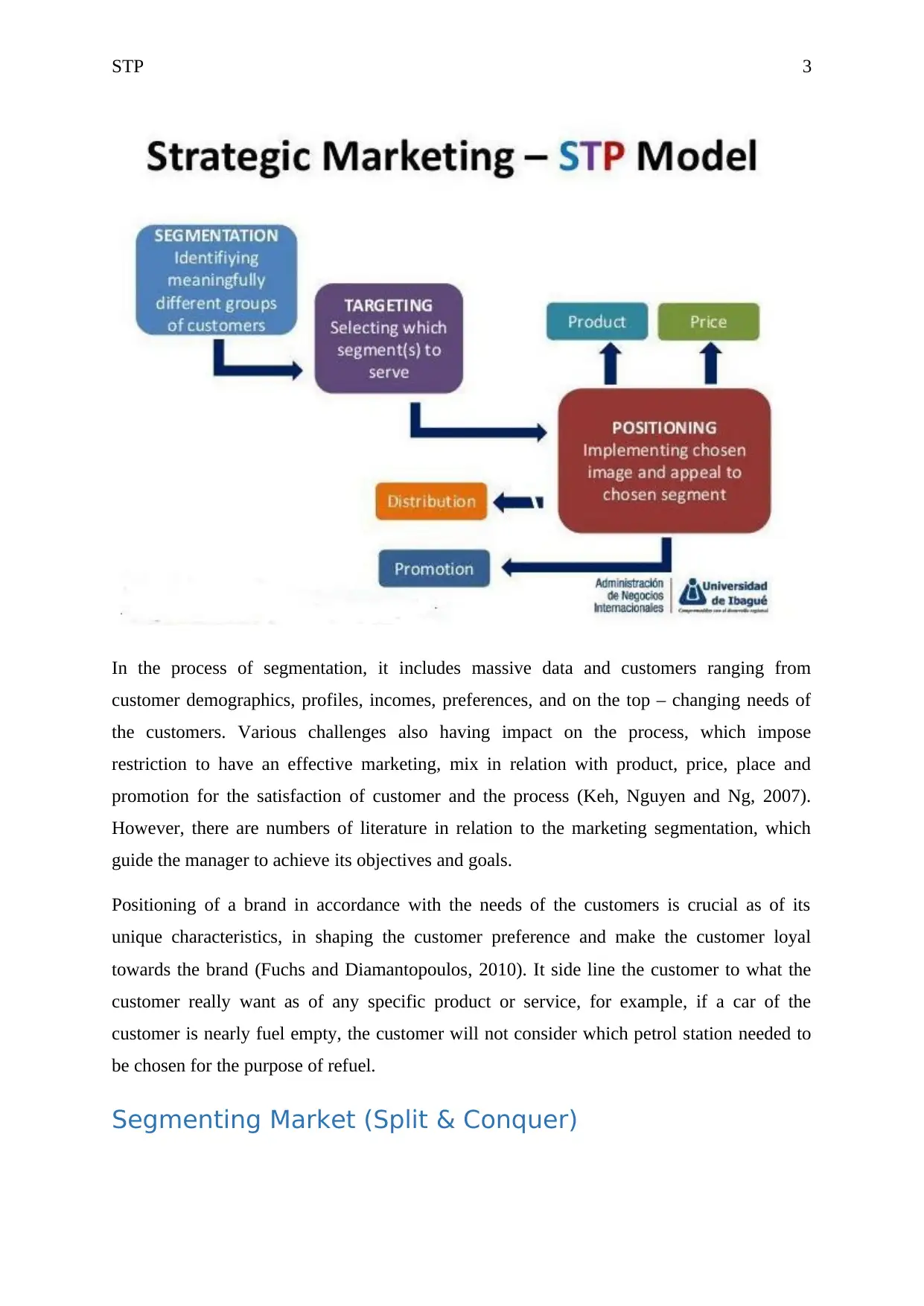
STP 3
In the process of segmentation, it includes massive data and customers ranging from
customer demographics, profiles, incomes, preferences, and on the top – changing needs of
the customers. Various challenges also having impact on the process, which impose
restriction to have an effective marketing, mix in relation with product, price, place and
promotion for the satisfaction of customer and the process (Keh, Nguyen and Ng, 2007).
However, there are numbers of literature in relation to the marketing segmentation, which
guide the manager to achieve its objectives and goals.
Positioning of a brand in accordance with the needs of the customers is crucial as of its
unique characteristics, in shaping the customer preference and make the customer loyal
towards the brand (Fuchs and Diamantopoulos, 2010). It side line the customer to what the
customer really want as of any specific product or service, for example, if a car of the
customer is nearly fuel empty, the customer will not consider which petrol station needed to
be chosen for the purpose of refuel.
Segmenting Market (Split & Conquer)
Figure 1
Source: (Kapferer and Bastien, 2012)
In the process of segmentation, it includes massive data and customers ranging from
customer demographics, profiles, incomes, preferences, and on the top – changing needs of
the customers. Various challenges also having impact on the process, which impose
restriction to have an effective marketing, mix in relation with product, price, place and
promotion for the satisfaction of customer and the process (Keh, Nguyen and Ng, 2007).
However, there are numbers of literature in relation to the marketing segmentation, which
guide the manager to achieve its objectives and goals.
Positioning of a brand in accordance with the needs of the customers is crucial as of its
unique characteristics, in shaping the customer preference and make the customer loyal
towards the brand (Fuchs and Diamantopoulos, 2010). It side line the customer to what the
customer really want as of any specific product or service, for example, if a car of the
customer is nearly fuel empty, the customer will not consider which petrol station needed to
be chosen for the purpose of refuel.
Segmenting Market (Split & Conquer)
Figure 1
Source: (Kapferer and Bastien, 2012)
Paraphrase This Document
Need a fresh take? Get an instant paraphrase of this document with our AI Paraphraser
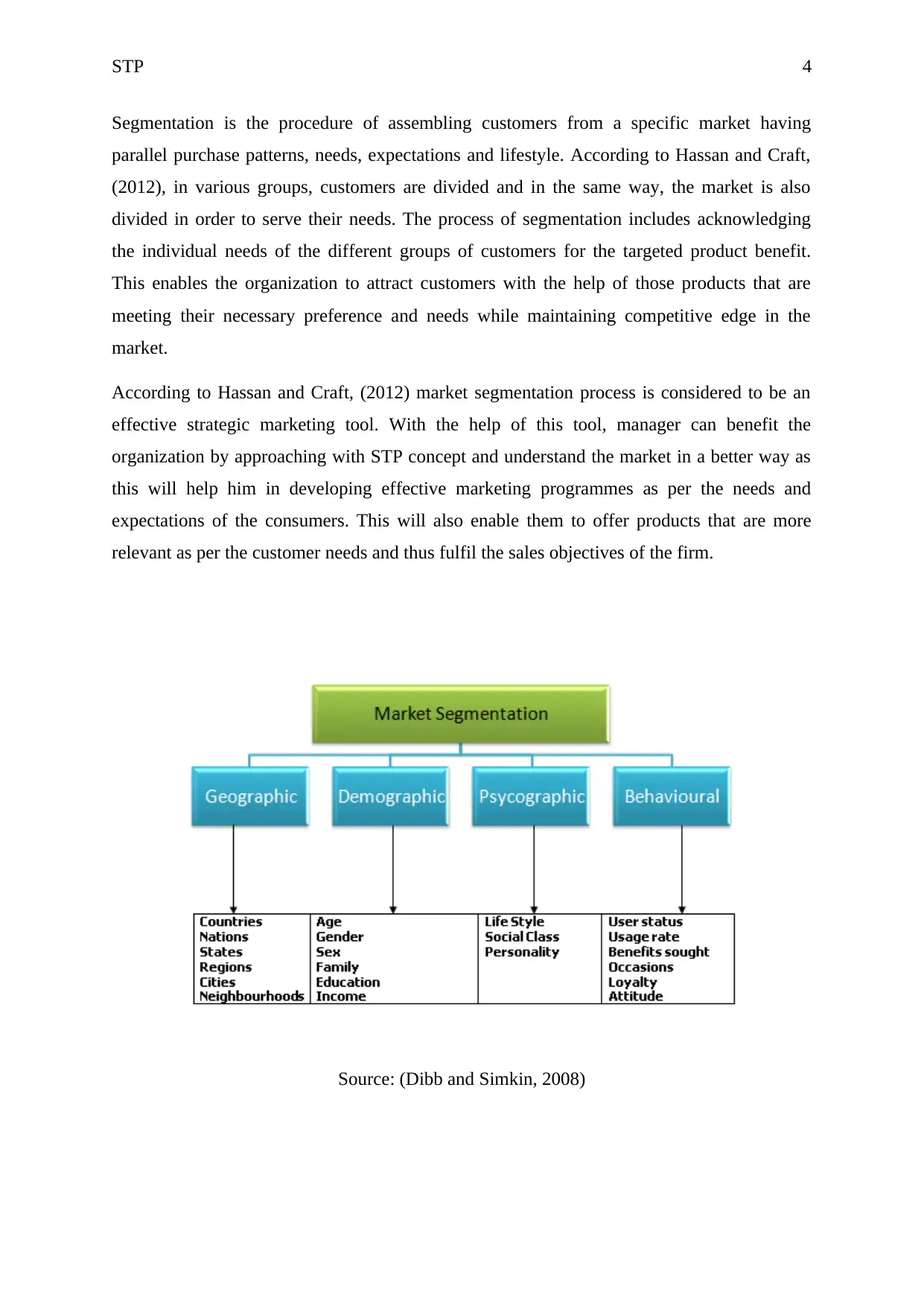
STP 4
Segmentation is the procedure of assembling customers from a specific market having
parallel purchase patterns, needs, expectations and lifestyle. According to Hassan and Craft,
(2012), in various groups, customers are divided and in the same way, the market is also
divided in order to serve their needs. The process of segmentation includes acknowledging
the individual needs of the different groups of customers for the targeted product benefit.
This enables the organization to attract customers with the help of those products that are
meeting their necessary preference and needs while maintaining competitive edge in the
market.
According to Hassan and Craft, (2012) market segmentation process is considered to be an
effective strategic marketing tool. With the help of this tool, manager can benefit the
organization by approaching with STP concept and understand the market in a better way as
this will help him in developing effective marketing programmes as per the needs and
expectations of the consumers. This will also enable them to offer products that are more
relevant as per the customer needs and thus fulfil the sales objectives of the firm.
Source: (Dibb and Simkin, 2008)
Segmentation is the procedure of assembling customers from a specific market having
parallel purchase patterns, needs, expectations and lifestyle. According to Hassan and Craft,
(2012), in various groups, customers are divided and in the same way, the market is also
divided in order to serve their needs. The process of segmentation includes acknowledging
the individual needs of the different groups of customers for the targeted product benefit.
This enables the organization to attract customers with the help of those products that are
meeting their necessary preference and needs while maintaining competitive edge in the
market.
According to Hassan and Craft, (2012) market segmentation process is considered to be an
effective strategic marketing tool. With the help of this tool, manager can benefit the
organization by approaching with STP concept and understand the market in a better way as
this will help him in developing effective marketing programmes as per the needs and
expectations of the consumers. This will also enable them to offer products that are more
relevant as per the customer needs and thus fulfil the sales objectives of the firm.
Source: (Dibb and Simkin, 2008)
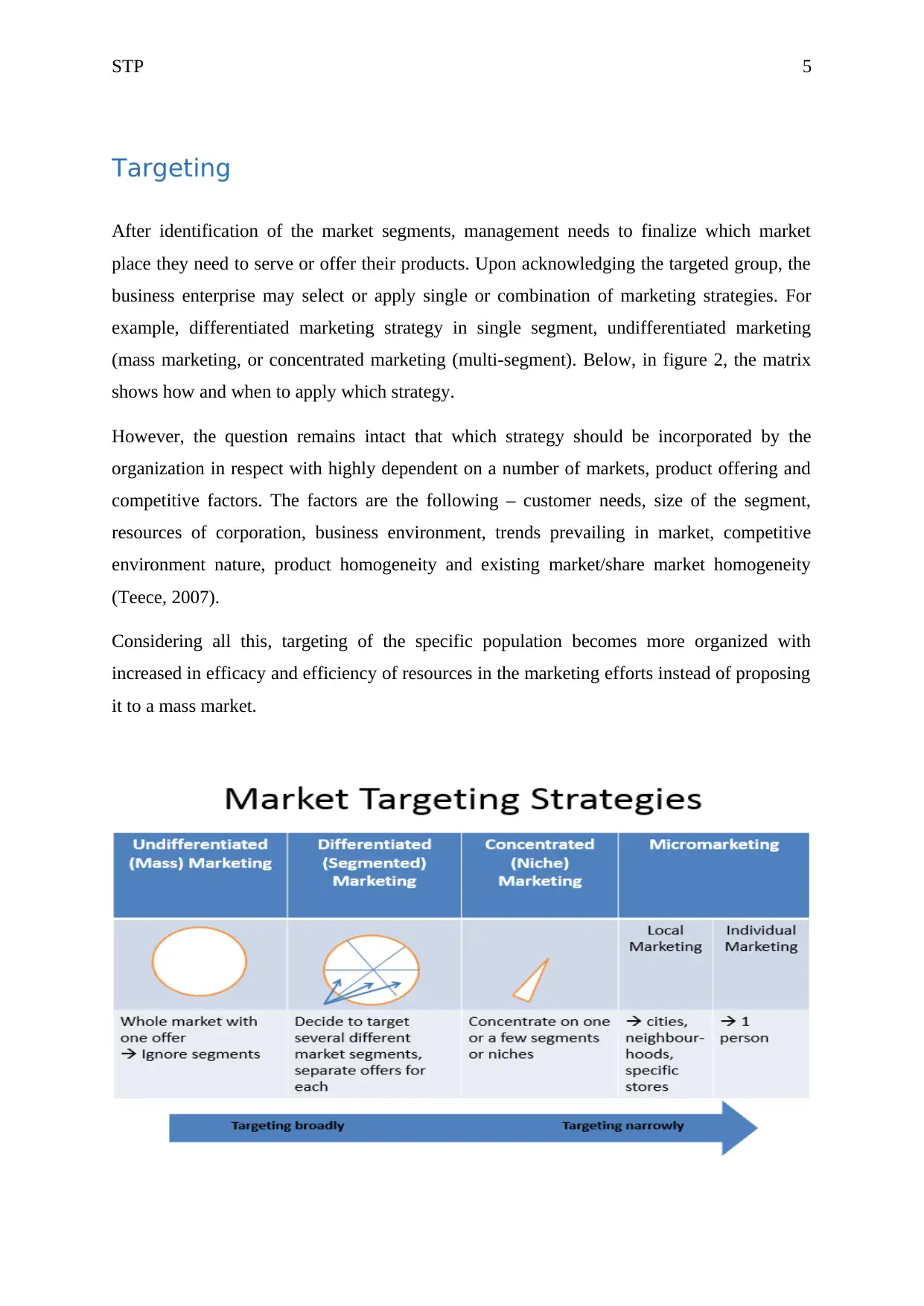
STP 5
Targeting
After identification of the market segments, management needs to finalize which market
place they need to serve or offer their products. Upon acknowledging the targeted group, the
business enterprise may select or apply single or combination of marketing strategies. For
example, differentiated marketing strategy in single segment, undifferentiated marketing
(mass marketing, or concentrated marketing (multi-segment). Below, in figure 2, the matrix
shows how and when to apply which strategy.
However, the question remains intact that which strategy should be incorporated by the
organization in respect with highly dependent on a number of markets, product offering and
competitive factors. The factors are the following – customer needs, size of the segment,
resources of corporation, business environment, trends prevailing in market, competitive
environment nature, product homogeneity and existing market/share market homogeneity
(Teece, 2007).
Considering all this, targeting of the specific population becomes more organized with
increased in efficacy and efficiency of resources in the marketing efforts instead of proposing
it to a mass market.
Targeting
After identification of the market segments, management needs to finalize which market
place they need to serve or offer their products. Upon acknowledging the targeted group, the
business enterprise may select or apply single or combination of marketing strategies. For
example, differentiated marketing strategy in single segment, undifferentiated marketing
(mass marketing, or concentrated marketing (multi-segment). Below, in figure 2, the matrix
shows how and when to apply which strategy.
However, the question remains intact that which strategy should be incorporated by the
organization in respect with highly dependent on a number of markets, product offering and
competitive factors. The factors are the following – customer needs, size of the segment,
resources of corporation, business environment, trends prevailing in market, competitive
environment nature, product homogeneity and existing market/share market homogeneity
(Teece, 2007).
Considering all this, targeting of the specific population becomes more organized with
increased in efficacy and efficiency of resources in the marketing efforts instead of proposing
it to a mass market.
⊘ This is a preview!⊘
Do you want full access?
Subscribe today to unlock all pages.

Trusted by 1+ million students worldwide
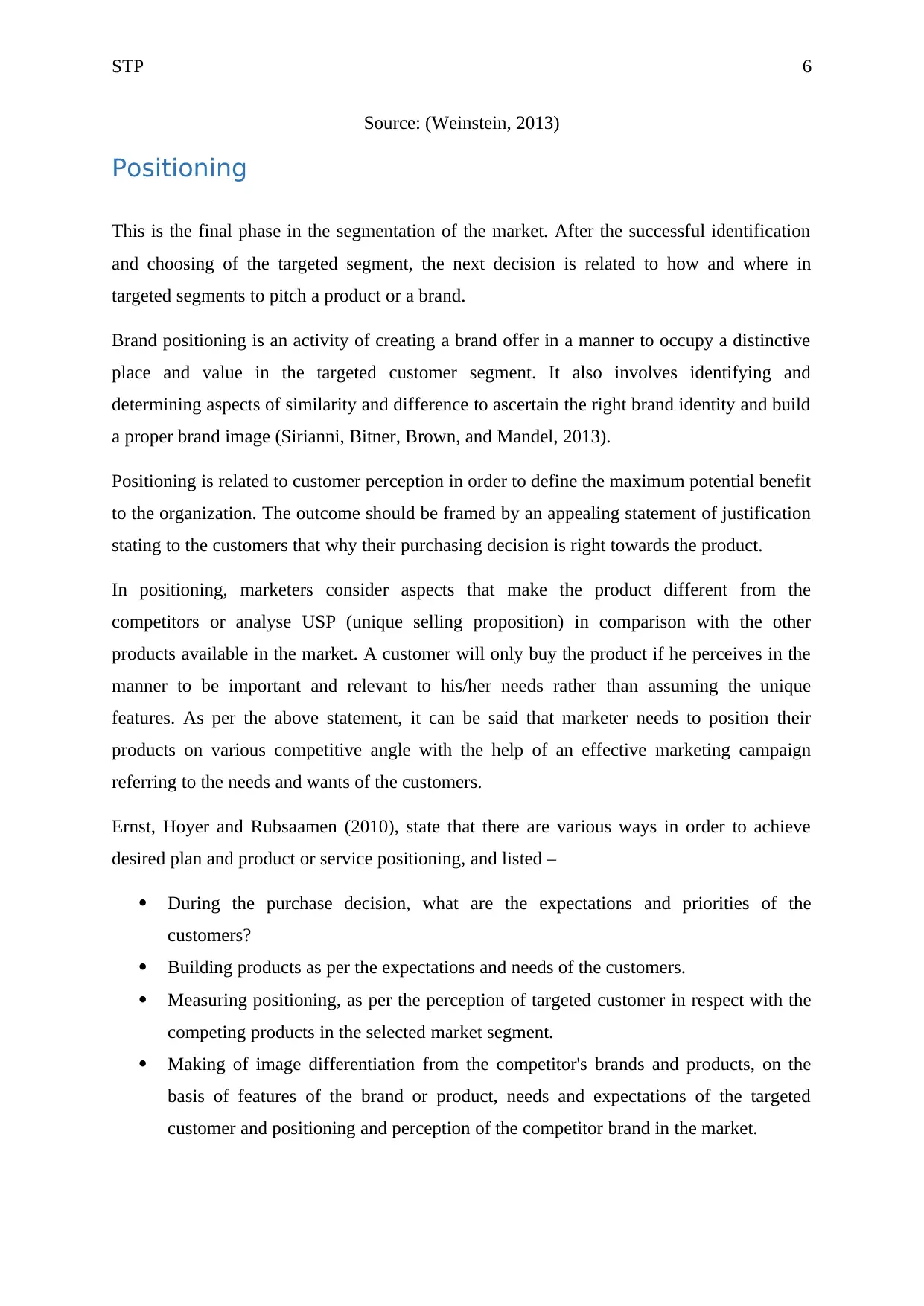
STP 6
Source: (Weinstein, 2013)
Positioning
This is the final phase in the segmentation of the market. After the successful identification
and choosing of the targeted segment, the next decision is related to how and where in
targeted segments to pitch a product or a brand.
Brand positioning is an activity of creating a brand offer in a manner to occupy a distinctive
place and value in the targeted customer segment. It also involves identifying and
determining aspects of similarity and difference to ascertain the right brand identity and build
a proper brand image (Sirianni, Bitner, Brown, and Mandel, 2013).
Positioning is related to customer perception in order to define the maximum potential benefit
to the organization. The outcome should be framed by an appealing statement of justification
stating to the customers that why their purchasing decision is right towards the product.
In positioning, marketers consider aspects that make the product different from the
competitors or analyse USP (unique selling proposition) in comparison with the other
products available in the market. A customer will only buy the product if he perceives in the
manner to be important and relevant to his/her needs rather than assuming the unique
features. As per the above statement, it can be said that marketer needs to position their
products on various competitive angle with the help of an effective marketing campaign
referring to the needs and wants of the customers.
Ernst, Hoyer and Rubsaamen (2010), state that there are various ways in order to achieve
desired plan and product or service positioning, and listed –
During the purchase decision, what are the expectations and priorities of the
customers?
Building products as per the expectations and needs of the customers.
Measuring positioning, as per the perception of targeted customer in respect with the
competing products in the selected market segment.
Making of image differentiation from the competitor's brands and products, on the
basis of features of the brand or product, needs and expectations of the targeted
customer and positioning and perception of the competitor brand in the market.
Source: (Weinstein, 2013)
Positioning
This is the final phase in the segmentation of the market. After the successful identification
and choosing of the targeted segment, the next decision is related to how and where in
targeted segments to pitch a product or a brand.
Brand positioning is an activity of creating a brand offer in a manner to occupy a distinctive
place and value in the targeted customer segment. It also involves identifying and
determining aspects of similarity and difference to ascertain the right brand identity and build
a proper brand image (Sirianni, Bitner, Brown, and Mandel, 2013).
Positioning is related to customer perception in order to define the maximum potential benefit
to the organization. The outcome should be framed by an appealing statement of justification
stating to the customers that why their purchasing decision is right towards the product.
In positioning, marketers consider aspects that make the product different from the
competitors or analyse USP (unique selling proposition) in comparison with the other
products available in the market. A customer will only buy the product if he perceives in the
manner to be important and relevant to his/her needs rather than assuming the unique
features. As per the above statement, it can be said that marketer needs to position their
products on various competitive angle with the help of an effective marketing campaign
referring to the needs and wants of the customers.
Ernst, Hoyer and Rubsaamen (2010), state that there are various ways in order to achieve
desired plan and product or service positioning, and listed –
During the purchase decision, what are the expectations and priorities of the
customers?
Building products as per the expectations and needs of the customers.
Measuring positioning, as per the perception of targeted customer in respect with the
competing products in the selected market segment.
Making of image differentiation from the competitor's brands and products, on the
basis of features of the brand or product, needs and expectations of the targeted
customer and positioning and perception of the competitor brand in the market.
Paraphrase This Document
Need a fresh take? Get an instant paraphrase of this document with our AI Paraphraser
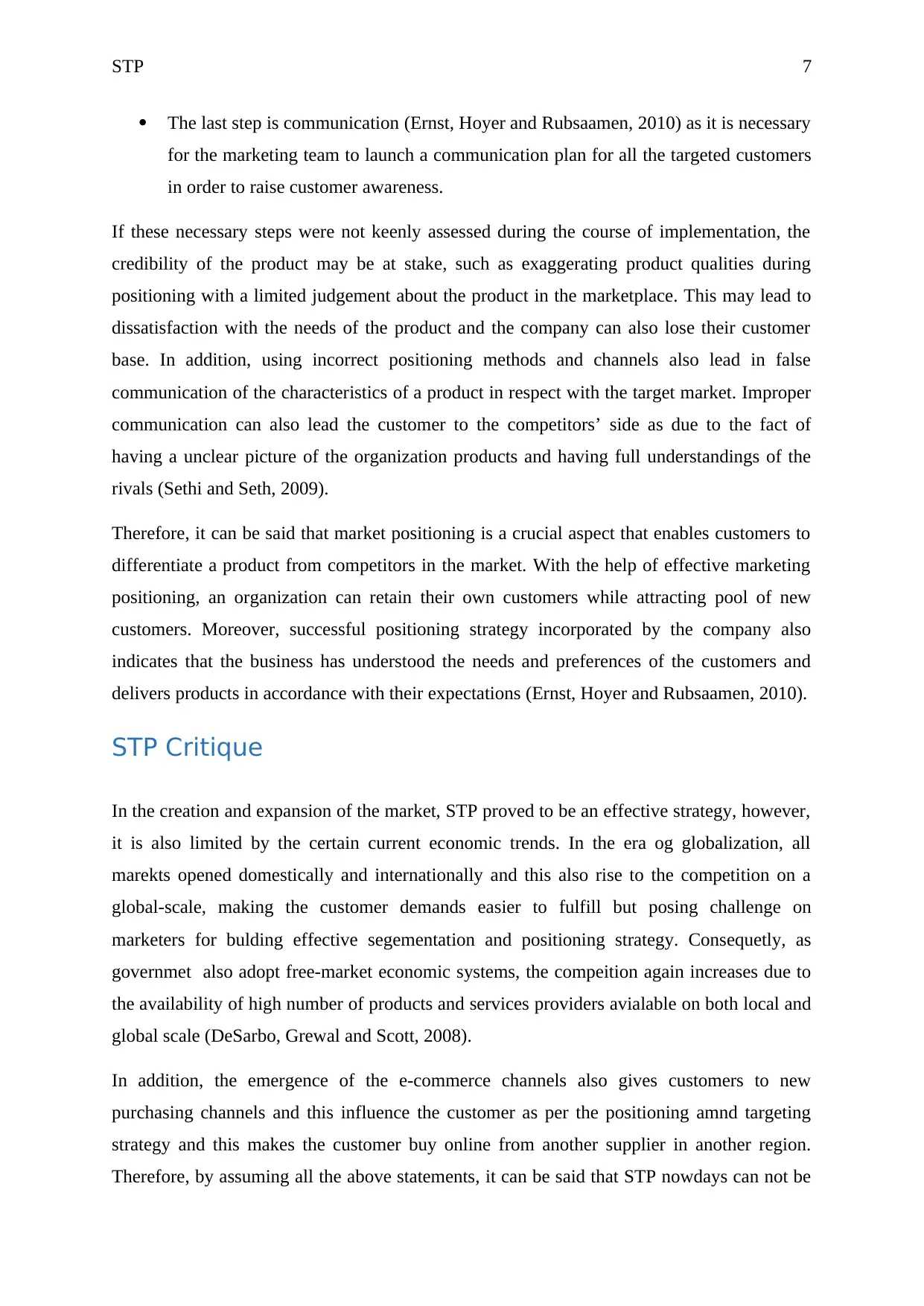
STP 7
The last step is communication (Ernst, Hoyer and Rubsaamen, 2010) as it is necessary
for the marketing team to launch a communication plan for all the targeted customers
in order to raise customer awareness.
If these necessary steps were not keenly assessed during the course of implementation, the
credibility of the product may be at stake, such as exaggerating product qualities during
positioning with a limited judgement about the product in the marketplace. This may lead to
dissatisfaction with the needs of the product and the company can also lose their customer
base. In addition, using incorrect positioning methods and channels also lead in false
communication of the characteristics of a product in respect with the target market. Improper
communication can also lead the customer to the competitors’ side as due to the fact of
having a unclear picture of the organization products and having full understandings of the
rivals (Sethi and Seth, 2009).
Therefore, it can be said that market positioning is a crucial aspect that enables customers to
differentiate a product from competitors in the market. With the help of effective marketing
positioning, an organization can retain their own customers while attracting pool of new
customers. Moreover, successful positioning strategy incorporated by the company also
indicates that the business has understood the needs and preferences of the customers and
delivers products in accordance with their expectations (Ernst, Hoyer and Rubsaamen, 2010).
STP Critique
In the creation and expansion of the market, STP proved to be an effective strategy, however,
it is also limited by the certain current economic trends. In the era og globalization, all
marekts opened domestically and internationally and this also rise to the competition on a
global-scale, making the customer demands easier to fulfill but posing challenge on
marketers for bulding effective segementation and positioning strategy. Consequetly, as
governmet also adopt free-market economic systems, the compeition again increases due to
the availability of high number of products and services providers avialable on both local and
global scale (DeSarbo, Grewal and Scott, 2008).
In addition, the emergence of the e-commerce channels also gives customers to new
purchasing channels and this influence the customer as per the positioning amnd targeting
strategy and this makes the customer buy online from another supplier in another region.
Therefore, by assuming all the above statements, it can be said that STP nowdays can not be
The last step is communication (Ernst, Hoyer and Rubsaamen, 2010) as it is necessary
for the marketing team to launch a communication plan for all the targeted customers
in order to raise customer awareness.
If these necessary steps were not keenly assessed during the course of implementation, the
credibility of the product may be at stake, such as exaggerating product qualities during
positioning with a limited judgement about the product in the marketplace. This may lead to
dissatisfaction with the needs of the product and the company can also lose their customer
base. In addition, using incorrect positioning methods and channels also lead in false
communication of the characteristics of a product in respect with the target market. Improper
communication can also lead the customer to the competitors’ side as due to the fact of
having a unclear picture of the organization products and having full understandings of the
rivals (Sethi and Seth, 2009).
Therefore, it can be said that market positioning is a crucial aspect that enables customers to
differentiate a product from competitors in the market. With the help of effective marketing
positioning, an organization can retain their own customers while attracting pool of new
customers. Moreover, successful positioning strategy incorporated by the company also
indicates that the business has understood the needs and preferences of the customers and
delivers products in accordance with their expectations (Ernst, Hoyer and Rubsaamen, 2010).
STP Critique
In the creation and expansion of the market, STP proved to be an effective strategy, however,
it is also limited by the certain current economic trends. In the era og globalization, all
marekts opened domestically and internationally and this also rise to the competition on a
global-scale, making the customer demands easier to fulfill but posing challenge on
marketers for bulding effective segementation and positioning strategy. Consequetly, as
governmet also adopt free-market economic systems, the compeition again increases due to
the availability of high number of products and services providers avialable on both local and
global scale (DeSarbo, Grewal and Scott, 2008).
In addition, the emergence of the e-commerce channels also gives customers to new
purchasing channels and this influence the customer as per the positioning amnd targeting
strategy and this makes the customer buy online from another supplier in another region.
Therefore, by assuming all the above statements, it can be said that STP nowdays can not be
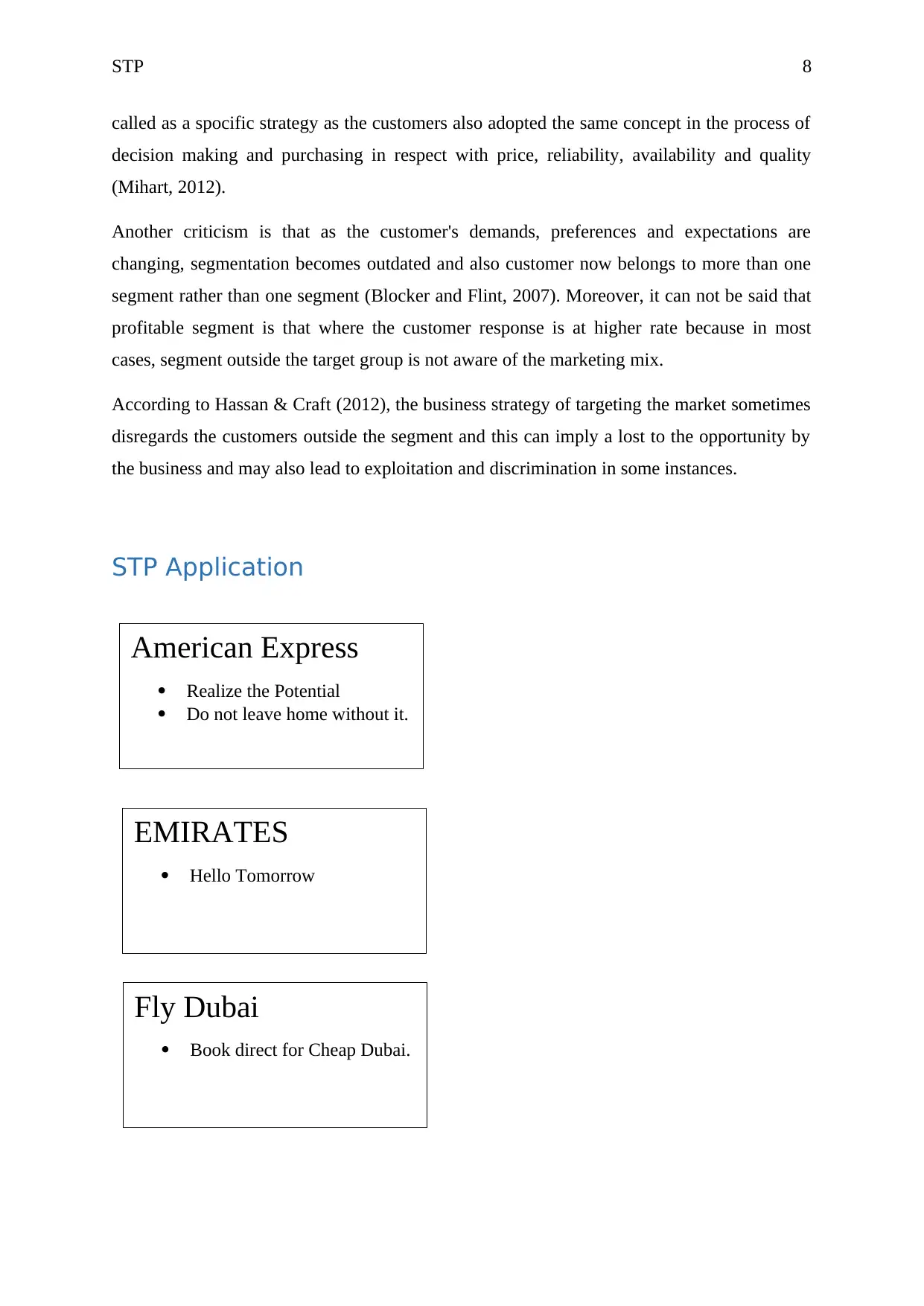
STP 8
called as a spocific strategy as the customers also adopted the same concept in the process of
decision making and purchasing in respect with price, reliability, availability and quality
(Mihart, 2012).
Another criticism is that as the customer's demands, preferences and expectations are
changing, segmentation becomes outdated and also customer now belongs to more than one
segment rather than one segment (Blocker and Flint, 2007). Moreover, it can not be said that
profitable segment is that where the customer response is at higher rate because in most
cases, segment outside the target group is not aware of the marketing mix.
According to Hassan & Craft (2012), the business strategy of targeting the market sometimes
disregards the customers outside the segment and this can imply a lost to the opportunity by
the business and may also lead to exploitation and discrimination in some instances.
STP Application
American Express
Realize the Potential
Do not leave home without it.
EMIRATES
Hello Tomorrow
Fly Dubai
Book direct for Cheap Dubai.
called as a spocific strategy as the customers also adopted the same concept in the process of
decision making and purchasing in respect with price, reliability, availability and quality
(Mihart, 2012).
Another criticism is that as the customer's demands, preferences and expectations are
changing, segmentation becomes outdated and also customer now belongs to more than one
segment rather than one segment (Blocker and Flint, 2007). Moreover, it can not be said that
profitable segment is that where the customer response is at higher rate because in most
cases, segment outside the target group is not aware of the marketing mix.
According to Hassan & Craft (2012), the business strategy of targeting the market sometimes
disregards the customers outside the segment and this can imply a lost to the opportunity by
the business and may also lead to exploitation and discrimination in some instances.
STP Application
American Express
Realize the Potential
Do not leave home without it.
EMIRATES
Hello Tomorrow
Fly Dubai
Book direct for Cheap Dubai.
⊘ This is a preview!⊘
Do you want full access?
Subscribe today to unlock all pages.

Trusted by 1+ million students worldwide
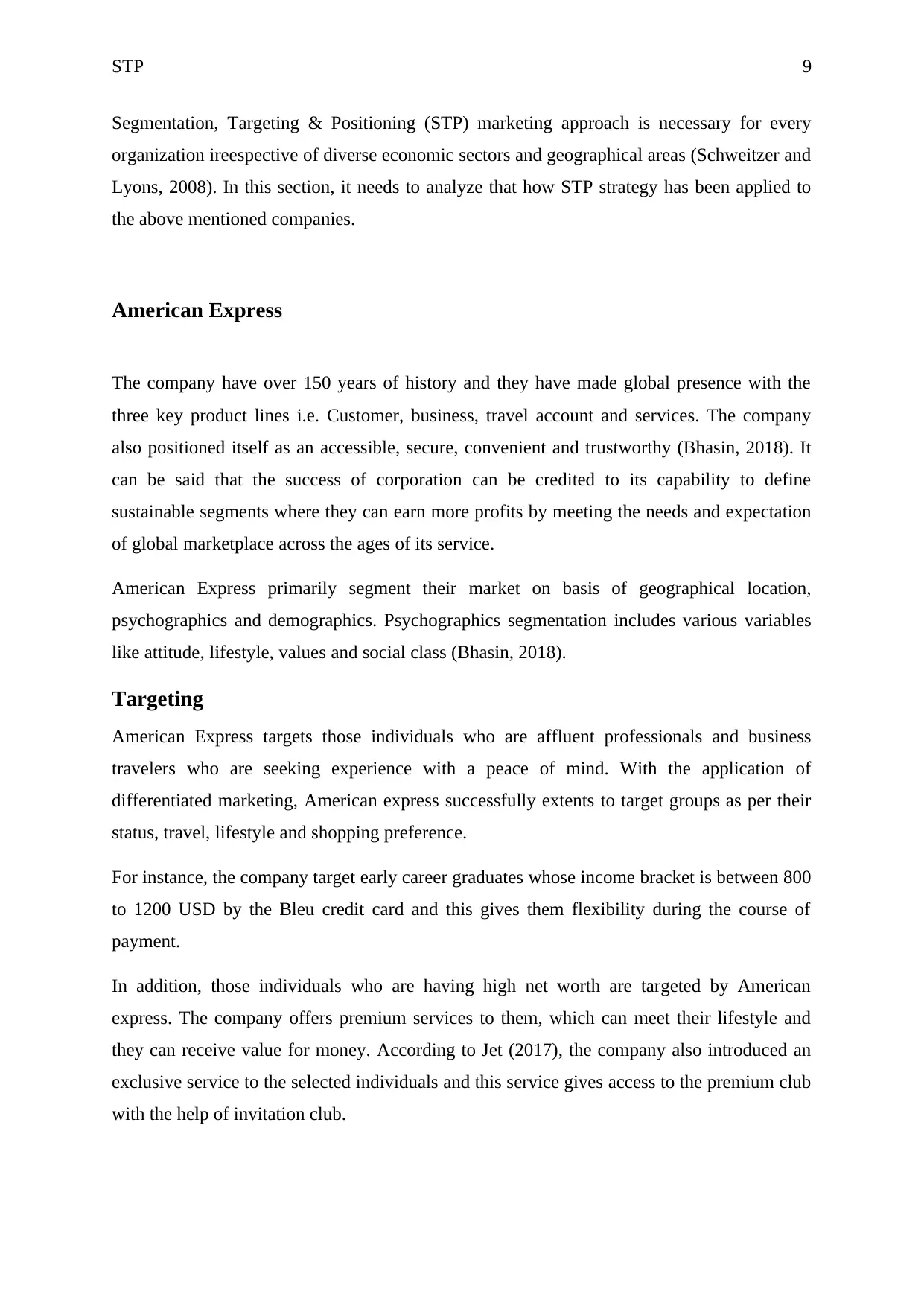
STP 9
Segmentation, Targeting & Positioning (STP) marketing approach is necessary for every
organization ireespective of diverse economic sectors and geographical areas (Schweitzer and
Lyons, 2008). In this section, it needs to analyze that how STP strategy has been applied to
the above mentioned companies.
American Express
The company have over 150 years of history and they have made global presence with the
three key product lines i.e. Customer, business, travel account and services. The company
also positioned itself as an accessible, secure, convenient and trustworthy (Bhasin, 2018). It
can be said that the success of corporation can be credited to its capability to define
sustainable segments where they can earn more profits by meeting the needs and expectation
of global marketplace across the ages of its service.
American Express primarily segment their market on basis of geographical location,
psychographics and demographics. Psychographics segmentation includes various variables
like attitude, lifestyle, values and social class (Bhasin, 2018).
Targeting
American Express targets those individuals who are affluent professionals and business
travelers who are seeking experience with a peace of mind. With the application of
differentiated marketing, American express successfully extents to target groups as per their
status, travel, lifestyle and shopping preference.
For instance, the company target early career graduates whose income bracket is between 800
to 1200 USD by the Bleu credit card and this gives them flexibility during the course of
payment.
In addition, those individuals who are having high net worth are targeted by American
express. The company offers premium services to them, which can meet their lifestyle and
they can receive value for money. According to Jet (2017), the company also introduced an
exclusive service to the selected individuals and this service gives access to the premium club
with the help of invitation club.
Segmentation, Targeting & Positioning (STP) marketing approach is necessary for every
organization ireespective of diverse economic sectors and geographical areas (Schweitzer and
Lyons, 2008). In this section, it needs to analyze that how STP strategy has been applied to
the above mentioned companies.
American Express
The company have over 150 years of history and they have made global presence with the
three key product lines i.e. Customer, business, travel account and services. The company
also positioned itself as an accessible, secure, convenient and trustworthy (Bhasin, 2018). It
can be said that the success of corporation can be credited to its capability to define
sustainable segments where they can earn more profits by meeting the needs and expectation
of global marketplace across the ages of its service.
American Express primarily segment their market on basis of geographical location,
psychographics and demographics. Psychographics segmentation includes various variables
like attitude, lifestyle, values and social class (Bhasin, 2018).
Targeting
American Express targets those individuals who are affluent professionals and business
travelers who are seeking experience with a peace of mind. With the application of
differentiated marketing, American express successfully extents to target groups as per their
status, travel, lifestyle and shopping preference.
For instance, the company target early career graduates whose income bracket is between 800
to 1200 USD by the Bleu credit card and this gives them flexibility during the course of
payment.
In addition, those individuals who are having high net worth are targeted by American
express. The company offers premium services to them, which can meet their lifestyle and
they can receive value for money. According to Jet (2017), the company also introduced an
exclusive service to the selected individuals and this service gives access to the premium club
with the help of invitation club.
Paraphrase This Document
Need a fresh take? Get an instant paraphrase of this document with our AI Paraphraser
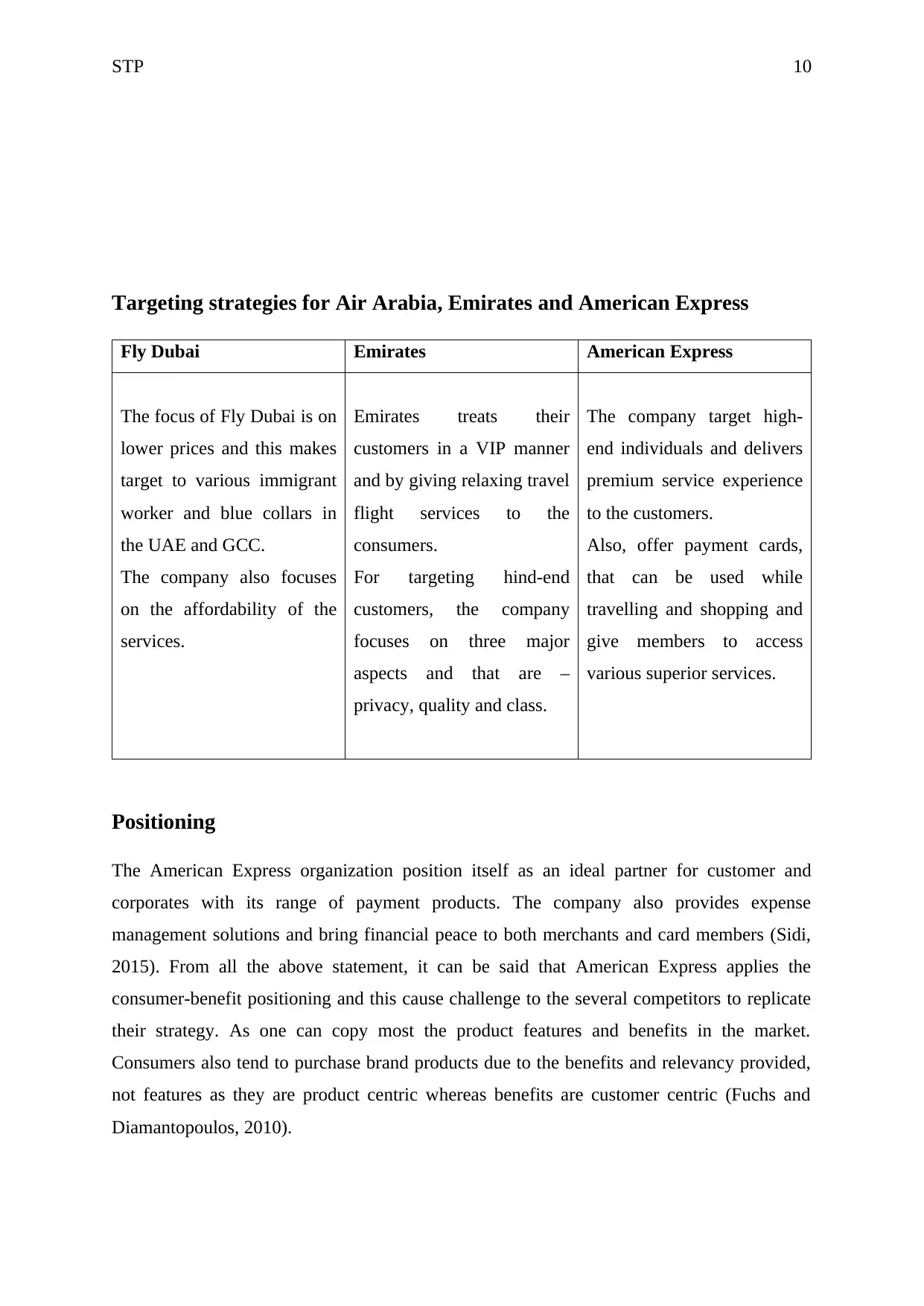
STP 10
Targeting strategies for Air Arabia, Emirates and American Express
Fly Dubai Emirates American Express
The focus of Fly Dubai is on
lower prices and this makes
target to various immigrant
worker and blue collars in
the UAE and GCC.
The company also focuses
on the affordability of the
services.
Emirates treats their
customers in a VIP manner
and by giving relaxing travel
flight services to the
consumers.
For targeting hind-end
customers, the company
focuses on three major
aspects and that are –
privacy, quality and class.
The company target high-
end individuals and delivers
premium service experience
to the customers.
Also, offer payment cards,
that can be used while
travelling and shopping and
give members to access
various superior services.
Positioning
The American Express organization position itself as an ideal partner for customer and
corporates with its range of payment products. The company also provides expense
management solutions and bring financial peace to both merchants and card members (Sidi,
2015). From all the above statement, it can be said that American Express applies the
consumer-benefit positioning and this cause challenge to the several competitors to replicate
their strategy. As one can copy most the product features and benefits in the market.
Consumers also tend to purchase brand products due to the benefits and relevancy provided,
not features as they are product centric whereas benefits are customer centric (Fuchs and
Diamantopoulos, 2010).
Targeting strategies for Air Arabia, Emirates and American Express
Fly Dubai Emirates American Express
The focus of Fly Dubai is on
lower prices and this makes
target to various immigrant
worker and blue collars in
the UAE and GCC.
The company also focuses
on the affordability of the
services.
Emirates treats their
customers in a VIP manner
and by giving relaxing travel
flight services to the
consumers.
For targeting hind-end
customers, the company
focuses on three major
aspects and that are –
privacy, quality and class.
The company target high-
end individuals and delivers
premium service experience
to the customers.
Also, offer payment cards,
that can be used while
travelling and shopping and
give members to access
various superior services.
Positioning
The American Express organization position itself as an ideal partner for customer and
corporates with its range of payment products. The company also provides expense
management solutions and bring financial peace to both merchants and card members (Sidi,
2015). From all the above statement, it can be said that American Express applies the
consumer-benefit positioning and this cause challenge to the several competitors to replicate
their strategy. As one can copy most the product features and benefits in the market.
Consumers also tend to purchase brand products due to the benefits and relevancy provided,
not features as they are product centric whereas benefits are customer centric (Fuchs and
Diamantopoulos, 2010).
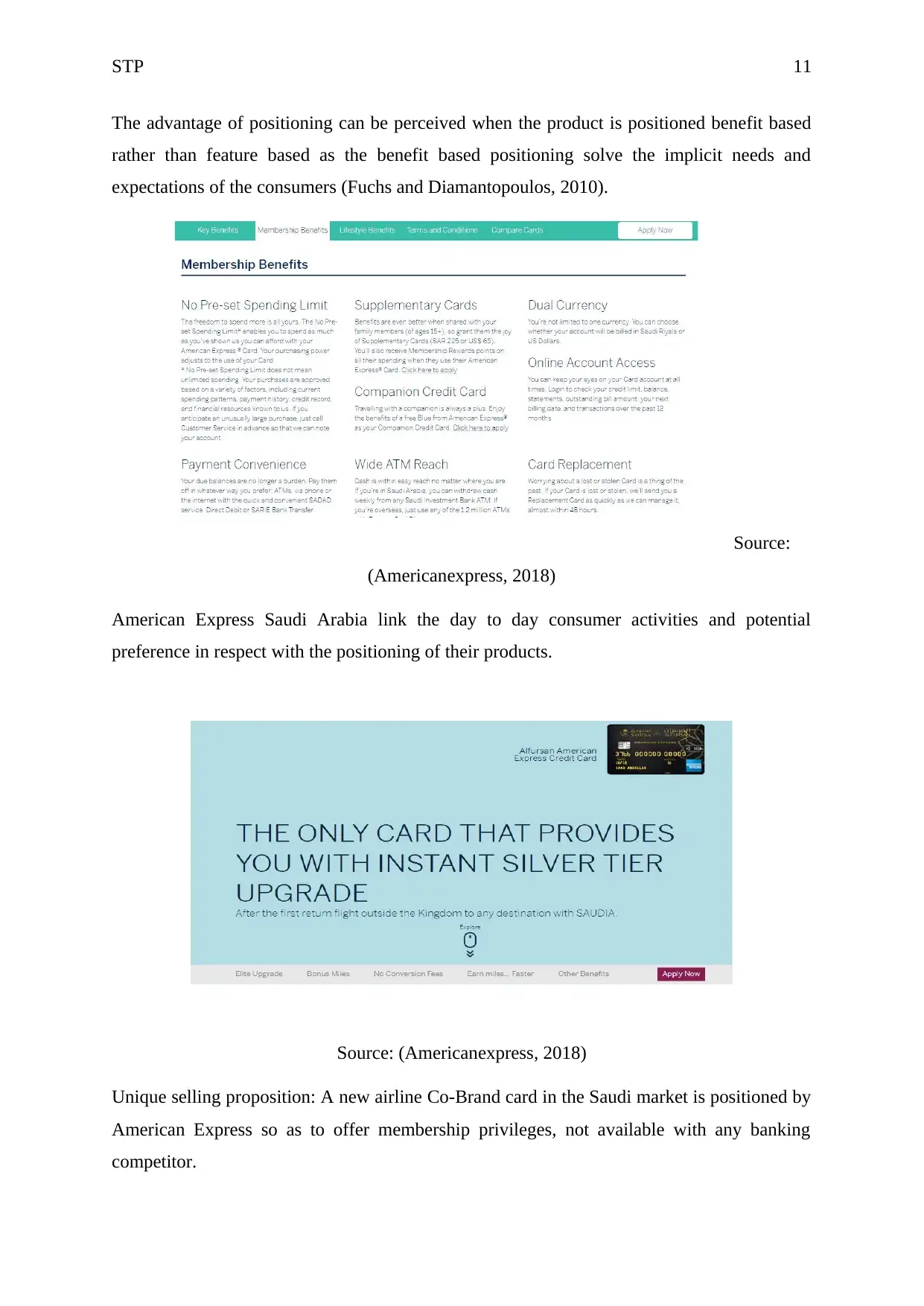
STP 11
The advantage of positioning can be perceived when the product is positioned benefit based
rather than feature based as the benefit based positioning solve the implicit needs and
expectations of the consumers (Fuchs and Diamantopoulos, 2010).
Source:
(Americanexpress, 2018)
American Express Saudi Arabia link the day to day consumer activities and potential
preference in respect with the positioning of their products.
Source: (Americanexpress, 2018)
Unique selling proposition: A new airline Co-Brand card in the Saudi market is positioned by
American Express so as to offer membership privileges, not available with any banking
competitor.
The advantage of positioning can be perceived when the product is positioned benefit based
rather than feature based as the benefit based positioning solve the implicit needs and
expectations of the consumers (Fuchs and Diamantopoulos, 2010).
Source:
(Americanexpress, 2018)
American Express Saudi Arabia link the day to day consumer activities and potential
preference in respect with the positioning of their products.
Source: (Americanexpress, 2018)
Unique selling proposition: A new airline Co-Brand card in the Saudi market is positioned by
American Express so as to offer membership privileges, not available with any banking
competitor.
⊘ This is a preview!⊘
Do you want full access?
Subscribe today to unlock all pages.

Trusted by 1+ million students worldwide
1 out of 18
Related Documents
Your All-in-One AI-Powered Toolkit for Academic Success.
+13062052269
info@desklib.com
Available 24*7 on WhatsApp / Email
![[object Object]](/_next/static/media/star-bottom.7253800d.svg)
Unlock your academic potential
Copyright © 2020–2025 A2Z Services. All Rights Reserved. Developed and managed by ZUCOL.




